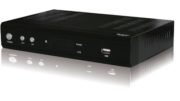This is a typical modern antenna. It’s usually referred to as a UHF antenna because it’s very good at pulling in UHF broadcasts. Yet, we’ve heard success stories of people getting VHF channels as well. Does that make it a VHF antenna? Well, sort of and sort of not.
Let’s break it down
It is technically possible to have antenna that gets only UHF, or for that matter an antenna that’s restricted to any range of frequencies. A notch filter is used on the antenna that stops all but the signals you want. In real life, though, that’s just another expense and something you don’t have to worry about because very few manufacturers bother with that step. In reality, everything made of metal has some ability to pick up every frequency, it’s just a matter of whether or not it’s terribly good at it.
Here’s the physics of it
What you really need to understand about antennas is that they work best when the actual length of the antenna is an even fraction of the wavelength. Every frequency corresponds to a particular wavelength, and if (just as an example) the wavelength is 3 feet, the perfect antenna for that wavelength would be 3 feet, or 1.5 feet, or .75 feet (or even 6 feet for that matter.) The point is that the size of the antenna fits evenly into the wavelength.
If it’s not a perfect fit, reception begins to suffer. However, lower frequencies are far more sensitive to that than higher frequencies, which is why you really need a lot of elements to get VHF signals, which are relatively low frequencies, and for the most part a single element pulls in all UHF frequencies, because their wavelengths make them more likely to be pulled in by antennas that are just a little bit off that perfect multiple.
Sometimes you get lucky
So there’s a funny thing that could happen, and often does- a UHF antenna could be a really close multiple of the perfect size for a particular VHF frequency. It could be exactly 1/8 the size it needs to be, or pretty close anyway, and that means it’s going to work pretty darn well for pulling in that channel. It can also happen when the antenna’s off axis from the transmitter, changing the size of the surface that pulls in the signal.
What does happen more often than not, though, is that the channel you think is VHF really isn’t. Just because it has a channel number under 14 doesn’t mean it’s really a VHF channel. It just means it probably once was. Within reason, broadcasters are actually free to call themselves whatever channel they want. A system called PSIP encodes the correct information, as well as the fake channel number, right in the broadcast. That way your TV understands that you mean channel 6 even though it’s really channel 42. It’s easy to find out the actual frequency for a station. Just do a Wikipedia search for its call letters. You’ll usually find it in there. You might be surprised to realize that all this time you thought that miraculous “VHF” antenna was pulling in UHF.
Get the antenna you need from Solid Signal
SolidSignal.com is your home for all the best brands of antennas at the best prices. You won’t find a better selection anywhere! Plus, we offer free support before and after the sale. It’s all part of the package. Try us now by shopping at solidsignal.com or calling us at 888-233-7563.





